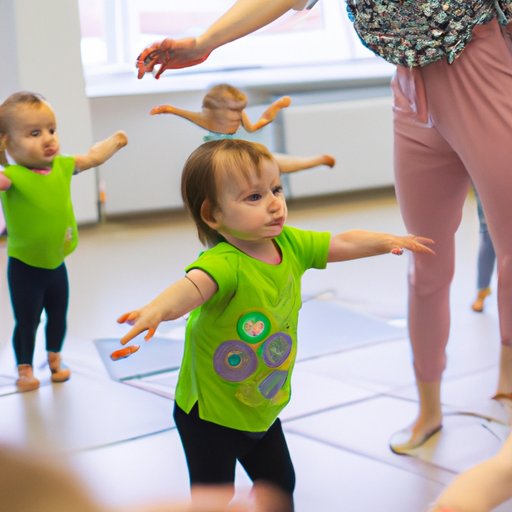Introduction
Dancing is an important part of childhood development, but when exactly do babies start to move their bodies in rhythm to music? In this article, we will explore the different ages when babies start to dance, the benefits of early music and movement, how parents can encourage their baby to move and dance, and what types of baby dance classes are available.

Analyzing the Different Ages When Babies Start to Dance
What age is typical for babies to start moving and dancing? According to a study published in Developmental Psychobiology, babies usually start to move to music between the ages of six and nine months. This age range is typically when babies start to become more aware of their own body and its movements. They may start to sway their arms and legs and bounce in time to the beat of the music.
Are there any factors that can influence the timing? Yes, several factors can influence when a baby starts to dance. For example, babies who are exposed to music earlier in life tend to show signs of dancing sooner than those who are not. Additionally, some babies may be more inclined to move to music due to their temperament or personality.
Exploring the Benefits of Early Music and Movement for Babies
How does music help develop motor skills in babies? Studies have shown that musical experiences can help babies develop gross and fine motor skills. These skills involve the coordination of large and small muscle groups, which are important for everyday activities such as crawling, walking, and writing. Music also helps babies learn about rhythm and beat, which are essential for dancing.
What other benefits are associated with early music and movement? Music and movement can also help babies learn language and communication skills. Through singing and dancing, babies can learn about social interaction and self-expression. In addition, music can provide a calming effect on babies and help them relax.
How Parents Can Encourage Their Baby to Move and Dance
Guidelines for introducing music and movement to babies: The best way to introduce music and movement to babies is through play. Parents can use simple instruments such as tambourines, maracas, or drums, and sing or clap along to create a fun and interactive experience. When playing with their babies, parents should try to keep a slow and steady rhythm that is easy for the baby to follow.
Tips for creating a positive environment for baby dance: Parents should create a safe and comfortable environment for their babies to dance in. They should make sure that the room is free from distractions and clutter, and that the temperature is comfortable. They should also ensure that the music they choose is not too loud or overwhelming for the baby. Finally, parents should always praise and encourage their baby’s efforts and never force them to dance.

Expert Advice on When Babies Should Begin Dancing
What do experts recommend for when babies should start dancing? According to experts, babies should begin dancing when they are ready. This typically occurs between the ages of six and nine months, but some babies may start dancing sooner or later depending on their individual development. Experts recommend that parents wait until their baby shows an interest in music and movement before introducing any formal dance classes.
What should parents keep in mind when introducing dance to their babies? Parents should always look for signs that their baby is ready to start dancing. These signs may include bouncing, swaying, and clapping in response to music. Additionally, parents should always make sure that their baby is having fun and not being forced into any activity.

A Comparison of Different Types of Baby Dance Classes
What types of baby dance classes are available? There are many different types of baby dance classes available, including ballet, tap, hip hop, jazz, and creative dance. Each type of class offers unique benefits, such as learning rhythm and coordination, building confidence, and developing creativity.
What are the pros and cons of each type of class? Ballet classes can help babies learn grace and poise, while tap classes can help them learn rhythm and coordination. Hip hop classes can help babies learn about body control and expression, while jazz classes can help them develop their sense of style. Creative dance classes can help babies express themselves freely and explore their imagination. However, it is important to keep in mind that all types of dance classes can be physically demanding and require a certain level of commitment.
Conclusion
In conclusion, babies usually start to move to music between the ages of six and nine months. Music and movement can help babies develop gross and fine motor skills, language and communication skills, and self-expression. To encourage their baby to move and dance, parents should create a safe and comfortable environment and introduce music and movement through play. There are many different types of baby dance classes available, each offering unique benefits. Ultimately, parents should wait until their baby shows an interest in music and movement before introducing any formal dance classes.
By understanding when babies start to dance, the benefits of early music and movement, and the different types of baby dance classes available, parents can create a positive and encouraging environment for their baby to explore music and movement.
(Note: Is this article not meeting your expectations? Do you have knowledge or insights to share? Unlock new opportunities and expand your reach by joining our authors team. Click Registration to join us and share your expertise with our readers.)
